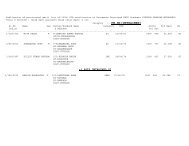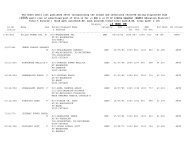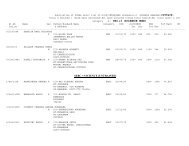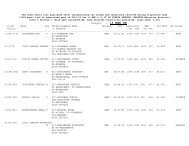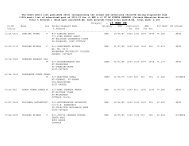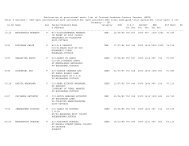Disaster Management Plan 2011-12 of Cuttack District
Disaster Management Plan 2011-12 of Cuttack District
Disaster Management Plan 2011-12 of Cuttack District
You also want an ePaper? Increase the reach of your titles
YUMPU automatically turns print PDFs into web optimized ePapers that Google loves.
1.1 Rational <strong>of</strong> DDMP<br />
MULTI-HAZARD DISASTER MANAGEMENT PLAN<br />
The district is vulnerable towards natural disasters like; floods, cyclones, droughts, earthquakes, sunstroke, fire<br />
accidents and others. Losses caused by disasters continue to mount year after year. The need for an effective disaster<br />
management strategy to lessen disaster impact is being felt in many quarters and also for strengthening <strong>of</strong> organizational<br />
structure for disaster management. Along with, regular updating <strong>of</strong> Codes / Manual / <strong>Disaster</strong> <strong>Plan</strong>s on the basis <strong>of</strong><br />
experience gained and technological developments should be done.<br />
Precise actions, procedures and responsibilities have to be laid down well in advance in order to ensure timely<br />
response in case <strong>of</strong> any disaster. Therefore, a mechanism that takes into account multiple hazards and basic<br />
preparedness has to be articulated in the form <strong>of</strong> Quick Response Teams, Quick Assessment Teams, Reporting<br />
Procedures, Checklist and Handbooks. The mechanism also lays down crucial parameters, requirements and<br />
organizational composition <strong>of</strong> Emergency Operations Centers and Incident Command Systems.<br />
1.2 Aim & Objective:<br />
• To mitigate impact <strong>of</strong> natural and man made disasters through preparedness at Dist./Block/G.P and Village level<br />
• To provide effective support and resources to all concerned individuals, groups and departments in disasters<br />
• To assists the Line Departments, Block Administration, communities in developing compatible skills for disasters<br />
preparedness and management.<br />
• To disseminate factual information in time<br />
• To develop immediate support to the affected people during the disasters<br />
• To create the awareness among the people about hazards and to increase their participation in preparedness,<br />
prevention, relief, rehabilitation.<br />
The <strong>District</strong> <strong>Disaster</strong> <strong>Management</strong> <strong>Plan</strong> (DDMP) has been envisaged as a preparedness plan whereby the receipt<br />
<strong>of</strong> a signal <strong>of</strong> an impending disaster would simultaneously energies and activates the mechanism for response and<br />
mitigation without loss <strong>of</strong> crucial time. This would be entail all the participating managers to know in advance the task<br />
assigned to them and the manner <strong>of</strong> response. Identification <strong>of</strong> available resources including manpower, material,<br />
equipment and adequate delegation <strong>of</strong> financial and administrative powers are prerequisites to successful operation <strong>of</strong> the<br />
DDMP.<br />
The DDMP is in essence, the Standard Operating Procedure (SOP) in which the implementation <strong>of</strong> efforts on<br />
ground is well laid down. Activities such as evacuation, search and rescue, temporary shelter, food, drinking water,<br />
clothing, health and sanitation are given prime importance. Communications accessibility and public information, that are<br />
important components <strong>of</strong> disaster management, would follow on the activation <strong>of</strong> the DDMP. These activities are common<br />
to all types <strong>of</strong> disasters and require subdivision and preparation <strong>of</strong> sub action plans by each specified authorities. Each<br />
sub group has been requested to work out the DDMP mechanism relevant to their group <strong>of</strong> disasters.<br />
The DDMP requires the disaster managers to;<br />
Evolve an effective signal/warning mechanism<br />
Identify activities and their levels<br />
Identify sub activities under each activity/level <strong>of</strong> activity<br />
Specify authorities for each level <strong>of</strong> activity and sub activity<br />
Determine the response time for each activity<br />
Workout individual plans <strong>of</strong> each specified authority to achieve activation as per the response time.<br />
Have quick response terms for each specified authority<br />
Have alternative plans and contingency measures<br />
Provide appropriate administrative and financial delegation to make the response mechanism functional viable<br />
Undergo preparedness drills.<br />
6



